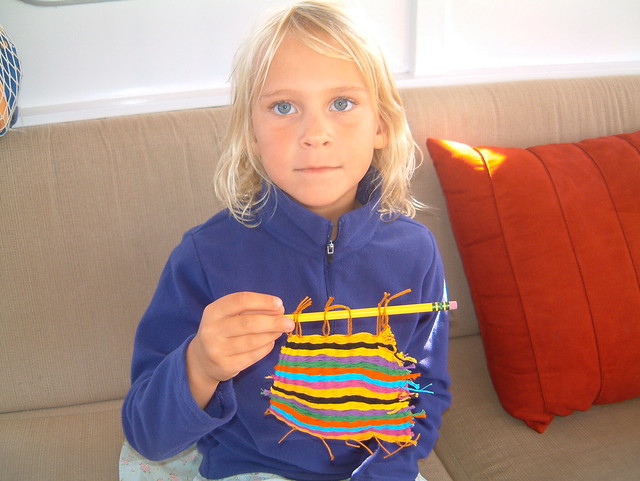This is the second most common question I receive when I am in public with the children—the first being “Are they all yours?” No doubt this question is a logical one for people who see a group of related kids playing in a park on a school day. Really, for the cruising family, there aren’t many other ways to handle schooling, but home-schools, or in our case, boat-schools, are as different as the families who choose this way of life.
There are only a few options when it comes to educating children: public school, private school, home-school and no school. On one extreme, you trust the raising of your precious humans to complete strangers (or, more cynically, the whims of the State), and on the other, you irresponsibly allow your child to raise himself (also called truancy). Somewhere in between you find private schools, which may be large or small, sacred or secular, live-in or correspondence, and home-schools, which range from Classical to Montessori, from-a-box to outside-the-box, and even a kind called “unschooling” whereby the education of the child is curiosity-driven, but still parent-directed.
Even before we decided to travel, we wanted our children to have an education directed by us, and not by the state of Florida. We like the holistic nature of homeschooling, where all aspects of human development are addressed. The curriculum can be designed to integrate all the subject matter in a way that makes sense and flows logically, instead of in a disjointed, contrived fashion. And with its rising popularity, home-schooling does not mean social isolation—there are a myriad of co-ops, classes, web-sites and support groups—so many that it requires discipline to actually stay home to do school.
We fall into the semi-Classical, outside-the-box category, I guess. That means I design interdisciplinary unit studies, generally history-based, and come up with creative ways to teach the content and help kids produce meaningful projects to show what they’ve learned (often by publishing their work in the form of hand-bound books). They do math in work books, but also learn through games, flash cards, real world problems and other teaching aids. Science is typically on-the-go, often driven by what we find around us, though it often plays a role in a unit study as well (for example, a study of the renaissance painters might also include anatomy lessons). Spelling and writing are usually related to whatever book we are reading in whatever history period we find ourselves. The kids do their own assigned reading and reading for pleasure, a recent addition as everyone is now up to speed. Happily, we are finding that they love to read and are reading books assigned to much older children, but which are certainly within their grasp.
Sarah, holding up a tapestry she wove on a home-made loom for a Middle Ages project
When we decided to buy our boat, we were able to maintain some semblance of normal routine despite the disruption to our environment. When we were doing half-time on the boat, we did school in the car—spelling tests, flash cards and books on CD. When we moved aboard at the dock, the library and museum were a block away, so we often did home-school-away-from-home. And now that we are cruising, the school routines that were firmly established before leaving continue despite constantly changing surroundings.
Another hidden benefit to home-schooling is the multitude of teachable moments that present themselves. We can actively seek out field trips that fit into what we are studying, but there are other spontaneous happenstances, like snorkeling on a reef, settlement museums in the Bahamas, collecting seaweed and invertebrates while wading in shallows or investigating a microcosm in floating seaweed with the help of our microscope, watching meteor showers and identifying constellations in dark skies, going to a foundry to learn how lost-wax sculptures are made, exploring a cave, talking to the welder who installed our arch and bimini about how his equipment works, and countless other opportunities to learn in real-life settings. Not to mention learning life skills like baking, typing, fishing, carpentry, engine repair, navigation, and sewing, to name a few. The children are required to do schoolwork and housework weekday mornings all year round, but have time in the afternoons for art, music, exercising or exploring, reading, and playing. For gutsy parents, it is the perfect solution, providing both structure and freedom.
Please Note: Parent-directed curriculum and teaching is not for the faint of heart. It is not easy to spend all day every day with one’s progeny, especially if they have inherited a stubborn streak of human nature from one or both parents. A teacher who wants a day off cannot call a substitute (unless Walt Disney counts), and without the direct accountability of a school, it would be pretty easy to drop the ball, a mistake for which both kids and parents would pay dearly. We are surely not doing a perfect job, and I am, as most homeschooling moms, fraught simultaneously with pride and self-doubt, but we are generally happy with our children’s progress and are eager to give them the world as a classroom.

